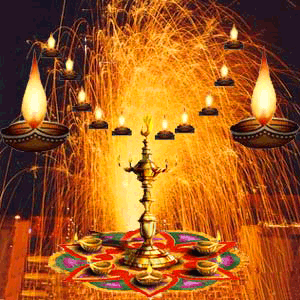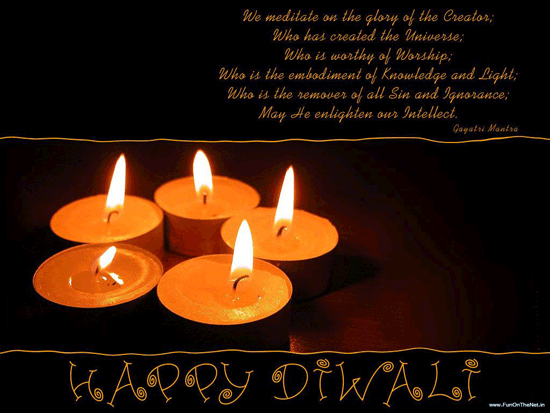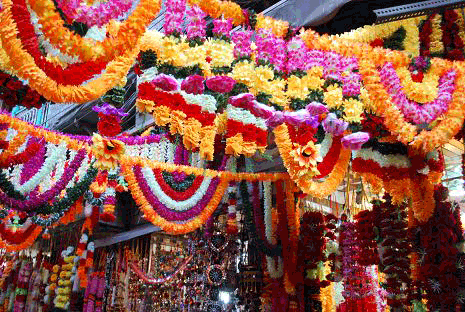DIWALI[[Diwali is the joyous celebration of the triumph of good over evil. It is the popular belief that the fireworks that add splendor to the festivities actually reduces the evil to ashes. The uniqueness of Diwali is that it harmonizes five varied philosophies, with each day assigned to commemorate a special thought or idea. According to a legend, which is also taken to be a history of diwali, the world celebrates Deepavali as the day the goddess stopped dancing after her battle with Mahishasura.The festival begins with Dhanteras, which is the celebration of the birth of goddess Lakshmi from the bottomless ocean. The second day is “Narak Chaturdhashi”, which commemmorates the felling of Narakasura by Satyabhama with the help of Indra. This is again another view of history of diwali. Some also believe that the second day is dedicated to Bali the generous king, who returns to his kingdom amidst celebrations. The most famous legend behind the celebrations of diwali is about the prince of Ayodhya, Lord Shri Ram Chandra, his defeating Ravana and his return from exile by lighting lamps on this darkest night of the year.]]
the “Festival of Lights”

In Hinduism, across many parts of India and Nepal, it is the homecoming of Lord Ram of Ayodhya, after a 14-year exile in the forest and his victory over the evil demon-king Ravan.[5] In the legend, the people of Ayodhya (the capital of his kingdom) welcomed Ram by lighting rows (avali) of lamps (deepa), thus its name: Deepavali. Over time, this word transformed into Diwali in Hindi and Dipawali in Nepali, but still retained its original form in South and East Indian Languages.
In Jainism, Diwali marks the attainment of nirvana by Lord Mahavira on 15 October, 527 BCE.
Diwali has been significant in Sikhism since the illumination of the town of Amritsar commemorating the return of Guru Har Gobind (1595-1644), the sixth Guru of Sikhism, who had been imprisoned along with 53 other Hindu Kings at Fort Gwalior by Emperor Jahangir. After his release he went to the Darbar Sahib (Golden Temple) in the holy city of Amritsar, where he was welcomed happily by the people who lit candles and diyas to greet the Guru. Because of this, Sikhs often refer to Diwali also as Bandi Chhorh Divas – “the day of release of detainees.”
The festival is also celebrated by Buddhists of Nepal, where majority of Hindu lives, particularly the Newar Buddhists.
In India and Nepal, Diwali is now considered to be a national festival, and the aesthetic aspect of the festival is enjoyed by most Indians and Nepalese regardless of faith.

Significance in Hinduism
The festival marks the victory of good over evil, and uplifting of spiritual darkness. Symbolically it marks the homecoming of goodwill and faith after an absence, as suggested by the Ramayana.
On the day of Diwali, many wear new clothes and share sweets and snacks. Some North Indian business communities start their financial year on Diwali and new account books are opened on this day.
Hindus have several significant events associated with it:
– Return of Lord Ram to Ayodhya: Diwali also celebrates the return of Lord Ram, King of Ayodhya, with his wife Sita and brother Lakshmana to Ayodhya after a 14 year exile, and a war in which he killed the evil and demonic king Ravan. It is believed that the people of Ayodhya lit ghee lamps along the way to light their path in the darkness. Since Lord Ram traveled from South India to his kingdom in North India, he passed through the south earlier. This is the reason why the festival is celebrated a day earlier in South India.
– The Killing of Narakasura: Celebrated as Narak Chaturdashi, one day before Diwali day, it commemorates the killing of Narakasura, an evil demon who created havoc, by Lord Krishna’s wife Satyabhama. This happened in the Dwapar Yuga during this time of Lord Krishna’s avatar. In another version, the demon was killed by Lord Krishna (Lord Krishna provokes his wife Satyabhama to kill Narakasura by pretending to be injured by the demon. Narakasura can only be killed by a woman) himself.[citation needed] Before Narakasura’s death, he requested a boon from Satyabhama (believed to be an Avatar of Bhudevi), that everyone should celebrate his death with colorful light.
– Austerities of Shakti: According to the Skanda Purana, the goddess Shakti observed 21 days of austerity starting from ashtami of shukla paksha (eighth day of the waxing period of moon) to get half of the body of Lord Shiva. This vrata (austerity) is known as kedhara vrata. Deepavali is the completion day of this austerity. This is the day Lord Shiva accepted Shakti into the left half of the form and appeared as Ardhanarishvara. The ardent devotees observe this 21 days vrata by making a kalasha with 21 threads on it and 21 types of offerings for 35 days. The final day is celebrated as kedhara gauri vrata. In eastern part of India, specially in Bengal, Kali puja has been celebrated on the day of Diwali.
– Birth of Goddess Lakshmi: According to the Puranas, the goddess of Wealth, Prosperity and Luck Lakshmi was born from the churning of the Milk Ocean, along with other magical beings and objects including Amrit, Kamadhenu,Chintamani, Halahal aka Poison, etc. She was sought by both the Devas(Gods) and Danavas(Demons) but she chose Vishnu as her husband.
Krishna defeating Indra: Govardhan Puja is celebrated the day after Diwali. It is the day Lord
– Krishna defeated Indra, the deity of thunder and rain. As per the story, Krishna saw huge preparations for the annual offering to Lord Indra and questions his father Nanda about it. He debated with the villagers about what their ‘dharma’ truly was. They were farmers, they should do their duty and concentrate on farming and protection of their cattle. He continued to say that all human beings should merely do their ‘karma’, to the best of their ability and not pray for natural phenomenon. The villagers were convinced by Krishna, and did not proceed with the special puja (prayer). Indra was then angered, and flooded the village. Krishna then lifted Mt Govardhan and held it up as protection to his people and cattle from the rain. Indra finally accepted defeat and recognized Krishna as supreme. This aspect of Krishna’s life is mostly glossed over[citation needed] but it set up the basis of the ‘karma’ philosophy later detailed in the Bhagavat Gita.
Spiritual Significance
While Deepavali is popularly known as the “festival of lights”, a more appropriate significance is “the new year of luck and wealth”.
Central to Hindu philosophy is the assertion that there is something beyond the physical body and mind which is pure, infinite, and eternal, called the Atman. Just as we celebrate the birth of our physical being, Deepavali is the celebration of this Inner Light, in particular the knowing of which outshines all darkness (removes all obstacles and dispels all ignorance), awakening the individual to one’s true nature, not as the body, but as the unchanging, infinite, immanent and transcendent reality. With the realization of the Atman comes universal compassion, love, and the awareness of the oneness of all things (higher knowledge). This brings Ananda (Inner Joy or Peace).
Diwali celebrates this through festive fireworks, lights, flowers, sharing of sweets, and worship. While the story behind Deepavali varies from region to region, the essence is the same – to rejoice in the Inner Light (Atman) or the underlying reality of all things (Brahman).
In Jainism
Diwali has a very special significance in Jainism, just like Buddha Purnima, the date of Buddha’s Nirvana, is for Buddhists as Christmas is for Christians. Lord Mahavira, the last of the Jain Tirthankaras, attained Nirvana or Moksha on this day at Pavapuri on Oct. 15, 527 BCE, on Chaturdashi of Kartika, as Tilyapannatti of Yativrashaba from the sixth century states:
Lord Mahavira is responsible for establishing the Dharma followed by Jains even today. According to tradition, the chief disciple of Mahavira, Ganadhara Gautam Swami also attained complete knowledge (Kevalgyana) on this day, thus making Diwali one of the most important Jain festivals.
Lord Mahavira attained his nirvana at the dawn of the amavasya (new moon). According to the Kalpasutra by Acharya Bhadrabahu, 3rd century BC, many gods were present there, illuminating the darkness.
Significance in Sikhism
The story of Diwali for the Sikhs is a story of the Sikh struggle for freedom. From the time of Guru Nanak (1469 – 1539), the founder of Sikhism, popular seasonal or folk festivals like the harvest festival of Baisakhi, or previously ancient Hindu festivals such as Holi and Diwali began to take on a new significance for the Guru’s students, the Sikhs. The Guru used these festivals and special days e.g. first day of each lunar month, as symbols or pegs for his teaching themes. The enlightened ideology of Guru Nanak gave new significance to ancient festivals like Diwali and Baisakhi

THE CELEBRATION OF “DIWALI”
On Diwali all the shops are decorated brightly. They are filled to capacity in this festive season. Everybody buys new things and decorates their homes. People visit their friends and relatives and give them sweets. On Diwali my friends come over for the whole day and relatives come and go. We have a wonderful time. Diwali is a day when all the sad things are forgotten and happy times are remembered.
Prayers to Laskmi, goddess of wealth, special clothes and the lighting of lamps marks the celebration of “Diwali” in many Indian homes.
Many people make “rangoli” in their house or outside. Rangoli is a pattern which is made on the floor, normally by coloured powder, but in the house it is made with paint. My mother and I once made a rangoli with coloured paper in our garden, but unfortunately it started to rain and all the powder was washed away. I felt a bit sad.
In the evening the family prays to Laskmi, the goddess of wealth. After the prayer I normally help my mother to put diyas (oil lamps) all around the house. After that I get ready and wear a “ghagra”. A ghagra is a long skirt with lots of designs on and has a blouse for the top. Then the family eats a grand meal together. The food to me tastes better than any food I ever had.
About 9.00 pm the fireworks start. This is the time when then whole of India is lit up. Everybody lights tons of fireworks until midnight. Then I go to sleep and don`t get up until the next morning. The day after Diwali is a new year according to the Hindu calendar Vikram-samvat 2055 and is yet another time for visiting. Diwali is celebrated from mid-October to mid-November. It is celebrated on a new moon day and it is my favorite time of the year.
Sources :
– www.internet-at-work.com
– Wikipedia




